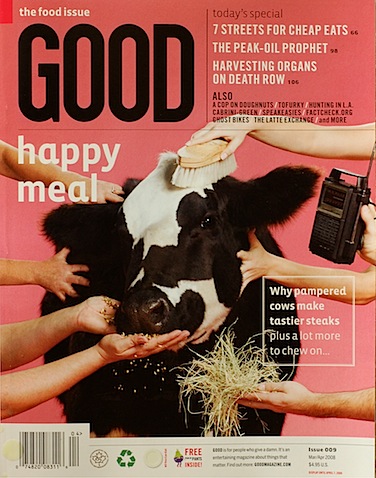
With a decidedly new take on the happy meal, the folks over at GOOD have filled their upcoming March/April issue with stories and photos about food along with their usual provocative round-up of art, politics and culture from around the world. Excellent visual design and a refreshingly straight-forward take on sustainability distinguish their pages. My friend Stewf introduced me to GOOD last year, on a camping trip no less, and since then I’ve been a loyal reader.
Be forewarned: this is not meant for the patchouli posse nor the bake-your-own-bread-after-grinding-your-own-wheat camp. Expect to see glints of flashy ads here and there. That said, my favorite sections include Statement, where the editors give an artist free rein with several pages at the beginning to set the theme and tone of the magazine. As a bit of an information wonk, I love Transparency for its always creative graphical exploration of intriguing, important data.
This food issue has a somewhat predictable feature on organic, free-range meat that will not be news to most who read this blog. Other pieces, though, offer interesting takes on what people are eating now in the U.S. Adam Leith Gollner’s predictions for “the next sushi” includes bibimbap and dosa. Photographer Vanessa Stump’s in-your-face layouts of everyday meals highlight the healthiest school lunch the magazine could find (Pasadena High School), military rations with squeezable apple jelly and a $250 pizza (wine not included).
With a bent toward revealing the power structure behind our consumer world, GOOD often highlights writers, photographers and graphic designers who can find new patterns in old realties. In this issue, Phil Howard shows which multinationals actually own your favorite organic snack. The magazine is based in New York, but the editors do manage to look west for stories on public housing in Chicago and an urban deer hunter in Los Angeles. There’s definitely an emphasis on stories from big cities, though.
One section’s title says it all: Provocations. Should we harvest the organs of death-row inmates? Should anthropologists be more involved in current military psyops? Do kids really need to learn handwriting with graphite and ink anymore? Read opinion pieces that are not afraid to take highly unpopular stands.
Finally, Good Project, the page that closes the magazine, invites readers to contribute their own ideas and creativity. The food issue ends with a call to send in photos and recipes for the best possible lunch that you could carry to work or school. It has to fit into a brown paper bag. And extra credit if you make all the food yourself.